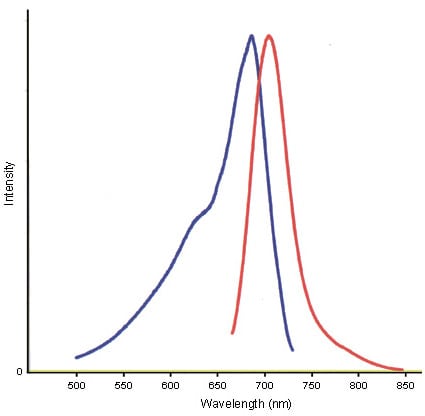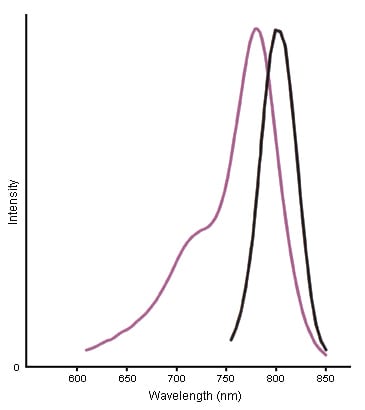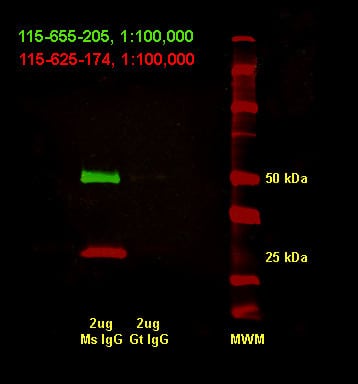
|

|
| Figure 1. Excitation and emission spectra of Alexa Fluor® 680 (left) and Alexa Fluor® 790 (right) conjugated secondary antibodies. All peaks were normalised. Spectra were obtained with an M-Series spectrofluorometer from Photon Technology International, Inc. and an Ultraspec 1100 pro from Amersham Biosciences. | |
Jackson ImmunoResearch now offers the largest selection of Alexa Fluor® 680 and Alexa Fluor® 790 dyes conjugated with signal-enhancing primary antibodies, affinity-purified secondary antibodies, streptavidin, and purified IgG controls for single and double-labelling Western blots (Figure 2) and other tecniques requiring high sensitivity. The secondary antibodies are adsorbed to eliminate cross-reactions with others species and with other immunoglobulin classes for double labelling.

|
| Figure 2. Double immunofluorescence staining on a Western blot using Alexa Fluor® 680 far-red dye and Alexa Fluor® 790 infrared dye. Mouse IgG and goat IgG were reduced and denatured with ß-mercaptoethanol and SDS. The heavy and light chains were separated by electrophoresis in SDS-PAGE, transferred to nitrocellulose, and double labelled with a 1:100,000 dilution of Alexa Fluor® 790-goat anti-mouse IgG, Fc? Subclass 1 specific (min X Hu, Bov, Rb Sr Prot, 115-655-205)(green) to detect heavy chains and a 1:100,000 dilution of Alex Fluor® 680-goat anti-mouse IgG, light chain specific (min X Bov, Gt, Hrs, Hu, Rb, Rat, Shp Ig, 115-625-174)(red) to detect light chains. Fluorescence was imaged in a LiCor Odyssey imager. Goat IgG was used as a background control. Note the faint bands of goat IgG heavy and light chains attesting to the extreme brightness of the dyes even at a dilution of 1:100000. |
Both dyes can be used with LiCor Odyssey imaging systems and all the high-sensitivity techniques listed above. We recommend that the antibodies be diluted at least 1:50,000 to 1:200,000 due to the high sensitivity of the conjugates.